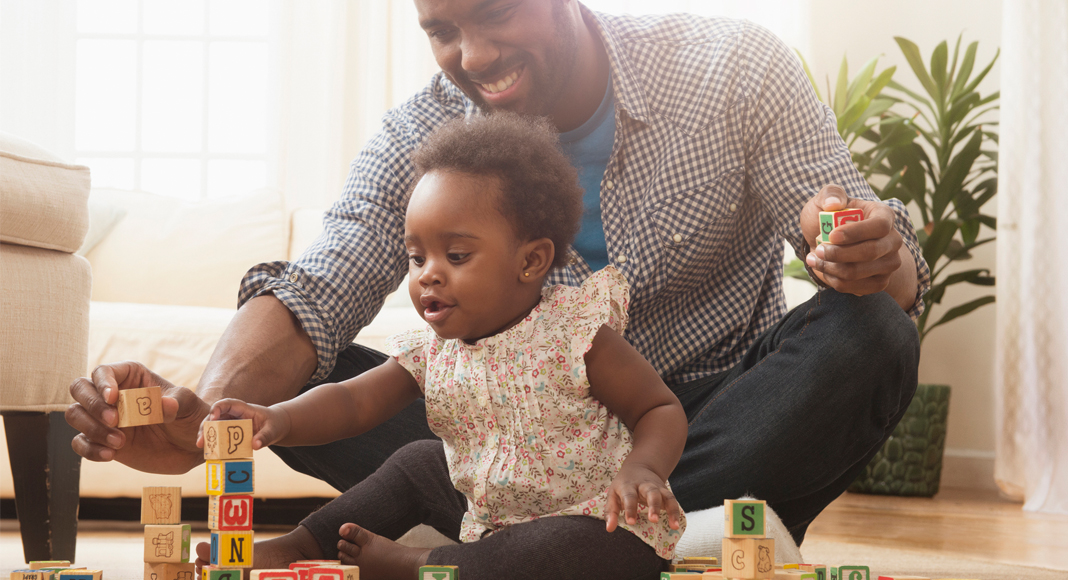 Are you working on holiday shopping? Perhaps you’re feeling overwhelmed by all the flashy toys for babies and toddlers that all claim to be good for development. If you still have gifts to buy for the kids on your list, Blank Children’s Hospital recommends the following developmental toys for babies and toddlers to make play fun and educational.
Are you working on holiday shopping? Perhaps you’re feeling overwhelmed by all the flashy toys for babies and toddlers that all claim to be good for development. If you still have gifts to buy for the kids on your list, Blank Children’s Hospital recommends the following developmental toys for babies and toddlers to make play fun and educational.
Infants: 0-4 Months
Babies prepare for developmental achievements during their early months through a mix of motor, sensory, and emotional experience. Sensory toys involving textures, sounds, and bright, contrasting colors are all great developmental choices for babies. By 4-months-old, babies can bring their hands together in the midline and use their eyes to coordinate hand movement.
| Toy Suggestions | Developmental Benefits |
| Rattles | Build grip and tactile stimulation |
| Mirrors | Improve focus on faces and objects (8-12 inches away). Stimulate social and language development |
| Musical mobiles | Stimulate hearing, stimulate infant to make sounds |
| Tripod gyms with dangling toys | Enhance reach and grasp, keeping head in midline, bringing hands together in midline |
| Books with baby faces, animals, high-contrast | Speech and language development, social and cognitive development |
| Colorful floor play mats | Enhance tummy play, developing strength in arms/legs |
Infants: 4-6 Months
Babies’ hands are now open, and they’re attempting to reach and grasp objects purposefully. First teeth usually start to erupt around 6 months old, and everything baby grasps is brought to mouth to teeth on. Objects need to be large enough to not fit completely in the mouth to avoid choking.
| Toy Suggestions | Developmental Benefits |
| Textured and/or chilled teethers | Cope with teething |
| Soft squeeze toys of different sizes and shape | Build grasping and manipulation |
| Peek-a-boo toys | Enhance object permanence |
Infants: 6-9 Months
At 6-months-old, babies can sit and manipulate objects with hands, and their movement patterns are more controlled.
| Toy Suggestions | Developmental Benefits |
| Baby blocks | Build fine motor skills |
| Toys that roll and make sounds when touched | Encourage creeping/crawling movement, enhance gross motor skills |
| Peek-a-boo toys | Enhance object permanence |
| Busy box | Manipulate objects and create cause/effect |
Infants: 9-12 Months
Babies are now able to get to sit and pull to stand independently, as well as start to crawl. Push toys need to have a broad, stable base to support babies’ weight and prevent falling.
| Toy Suggestions | Developmental Benefits |
| Sensory balls (textured) | Promote gross motor and tactile skills, as well as grasping, coordination, and crawling; can also be used for relaxation and body massage |
| Toys where baby can put items into containers | Develop gross and fine motor skills |
| Pat-a-cake, peek-a-boo, or toys/books that have hide and seek effect | Enhance object permanence |
Infants: 12-15 Months
Cognitive development accelerates around babies’ first birthdays. Cause and effect toys are fun yet challenging. Babies are starting to use words meaningfully. They are now standing independently, walking, and exploring their environment.
| Toy Suggestions | Developmental Benefits |
| Stackable cubes | Increase fine motor skills, cognitive development of spatial relations |
| Puzzles with easy-grasp knobs | Build fine motor skills, hand-eye coordination, enhance expressive and receptive language and cognitive development (giving one-step commands, as you talk about finding specific puzzle pieces) |
| Cause and effect toys | Enhance object permanence and challenge |
Toddlers: 24 Months to 3+ Years
One of the best educational and developmental activities for busy toddlers is simple: reading! No matter your child’s age, reading a book together enhances speech and language development, as well as social and cognitive development. Reading also instills in a child the love of reading for a lifetime!
Toddlers are starting to name colors, point, and name pictures, make animal sounds, begin to count, and carry on simple conversations. Make storytime interactive, pausing the book to ask questions about the story and see what your toddler comprehends. Incorporate books that are relevant to your toddlers’ daily activities, like potty training, daycare, preschool, siblings, mealtime, and pets.
Parents can also use technology to assist with their child’s development. There are many free educational and fun preschool apps for toddlers designed to help them learn colors, shapes, counting, ABC’s and other activities that enhance their problem-solving abilities. However, as with any activity, moderation is key; the American Academy of Pediatrics recommends no more than one hour of screen time per day for children ages 2-5.
For more information on child development, contact your child’s pediatrician. Need help finding a pediatrician? Visit Blank Children’s Hospital or use the Find a Doctor or Find a Location tools.
To share a gift this holiday season with a child at Blank Children’s Hospital, visit their Child Life Christmas Wish List. For more information about tax-deductible giving to Blank Children’s visit their website.
Connect with UnityPoint Health Des Moines
Website
Facebook
Twitter
YouTube
Instagram
Pinterest
This post is part of a series of sponsored posts by UnityPoint Health Des Moines.
Tips for High-Risk Pregnancies
Summer Safety Tips from Blank Children’s Hospital
Fun Indoor Activities for Winter
















